landscape
Type of resources
Available actions
Topics
INSPIRE themes
Keywords
Contact for the resource
Provided by
Years
Formats
Representation types
Update frequencies
status
Resolution
-

CORINE Land Cover (CLC) was specified to standardize data collection on land in Europe to support environmental policy development. The reference year of first CLC inventory was 1990 (CLC1990), and the first update created in 2000. Later the update cycle has become 6 years. The number of participating countries has increased over time − currently includes 33 European Environment Agency (EEA) member countries and six cooperating countries (EEA39) with a total area of over 5.8 Mkm2. Ortho-corrected high spatial resolution satellite images provide the geometrical and thematic basis for mapping. In-situ data (topographic maps, ortho-photos and ground survey data) are essential ancillary information. The project is coordinated by the EEA in the frame of the EU Copernicus programme and implemented by national teams under the management and quality control (QC) of the EEA. The basic technical parameters of CLC (i.e. 44 classes in nomenclature, 25 hectares minimum mapping unit (MMU) and 100 meters minimum mapping width) have not changed since the beginning, therefore the results of the different inventories are comparable. The layer of CORINE Land Cover Changes (CLCC) is produced since the second CLC inventory (CLC2000). CLCC is derived from satellite imagery by direct mapping of changes taken place between two consecutive inventories, based on image-to-image comparison. Change mapping applies a 5 ha MMU to pick up more details in CLCC layer than in CLC status layer. Integration of national CLC and CLCC data includes some harmonization along national borders. Two European validation studies have shown that the achieved thematic accuracy is above the specified minimum (85 %). Primary CLC and CLCC data are in vector format with polygon topology. Derived products in raster format are also available. The seamless European CLC and CLCC time series data (CLC1990, CLC2000, CLC2006, CLC2012 and related CLCC data) are distributed in the standard European Coordinate Reference System defined by the European Terrestrial Reference System 1989 (ETRS89) datum and Lambert Azimuthal Equal Area (LAEA) projection (EPSG: 3035). Results of the CLC inventories can be downloaded from Copernicus Land site free of charge for all users. CLC data can contribute to a wide range of studies with European coverage, e.g.: ecosystem mapping, modelling the impacts of climate change, landscape fragmentation by roads, abandonment of farm land and major structural changes in agriculture, urban sprawl, water management.
-

CORINE Land Cover (CLC) was specified to standardize data collection on land in Europe to support environmental policy development. The reference year of first CLC inventory was 1990 (CLC1990), and the first update created in 2000. Later the update cycle has become 6 years. The number of participating countries has increased over time − currently includes 33 European Environment Agency (EEA) member countries and six cooperating countries (EEA39) with a total area of over 5.8 Mkm2. Ortho-corrected high spatial resolution satellite images provide the geometrical and thematic basis for mapping. In-situ data (topographic maps, ortho-photos and ground survey data) are essential ancillary information. The project is coordinated by the EEA in the frame of the EU Copernicus programme and implemented by national teams under the management and quality control (QC) of the EEA. The basic technical parameters of CLC (i.e. 44 classes in nomenclature, 25 hectares minimum mapping unit (MMU) and 100 meters minimum mapping width) have not changed since the beginning, therefore the results of the different inventories are comparable. The layer of CORINE Land Cover Changes (CHA) is produced since the second CLC inventory (CLC2000). CHA is derived from satellite imagery by direct mapping of changes taken place between two consecutive inventories, based on image-to-image comparison. Change mapping applies a 5 ha MMU to pick up more details in CHA layer than in CHA status layer. Integration of national CLC and CHA data includes some harmonization along national borders. Two European validation studies have shown that the achieved thematic accuracy is above the specified minimum (85 %). Primary CLC and CHA data are in vector format with polygon topology. Derived products in raster format are also available. The seamless European CLC and CHA time series data (CLC1990, CLC2000, CLC2006, CLC2012, CLC2018 and related CHA data) are distributed in the standard European Coordinate Reference System defined by the European Terrestrial Reference System 1989 (ETRS89) datum and Lambert Azimuthal Equal Area (LAEA) projection (EPSG: 3035). Results of the CLC inventories can be downloaded from Copernicus Land site free of charge for all users. CLC data can contribute to a wide range of studies with European coverage, e.g.: ecosystem mapping, modelling the impacts of climate change, landscape fragmentation by roads, abandonment of farm land and major structural changes in agriculture, urban sprawl, water management.
-
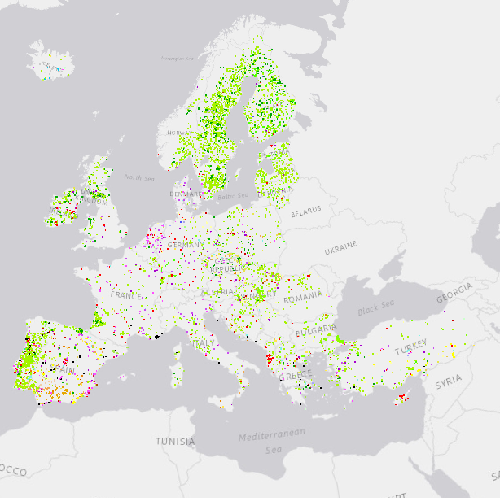
CORINE Land Cover (CLC) was specified to standardize data collection on land in Europe to support environmental policy development. The reference year of first CLC inventory was 1990 (CLC1990), and the first update created in 2000. Later the update cycle has become 6 years. The number of participating countries has increased over time − currently includes 33 European Environment Agency (EEA) member countries and six cooperating countries (EEA39) with a total area of over 5.8 Mkm2. Ortho-corrected high spatial resolution satellite images provide the geometrical and thematic basis for mapping. In-situ data (topographic maps, ortho-photos and ground survey data) are essential ancillary information. The project is coordinated by the EEA in the frame of the EU Copernicus programme and implemented by national teams under the management and quality control (QC) of the EEA. The basic technical parameters of CLC (i.e. 44 classes in nomenclature, 25 hectares minimum mapping unit (MMU) and 100 meters minimum mapping width) have not changed since the beginning, therefore the results of the different inventories are comparable. The layer of CORINE Land Cover Changes (CLCC) is produced since the second CLC inventory (CLC2000). CLCC is derived from satellite imagery by direct mapping of changes taken place between two consecutive inventories, based on image-to-image comparison. Change mapping applies a 5 ha MMU to pick up more details in CLCC layer than in CLC status layer. Integration of national CLC and CLCC data includes some harmonization along national borders. Two European validation studies have shown that the achieved thematic accuracy is above the specified minimum (85 %). Primary CLC and CLCC data are in vector format with polygon topology. Derived products in raster format are also available. The seamless European CLC and CLCC time series data (CLC1990, CLC2000, CLC2006, CLC2012 and related CLCC data) are distributed in the standard European Coordinate Reference System defined by the European Terrestrial Reference System 1989 (ETRS89) datum and Lambert Azimuthal Equal Area (LAEA) projection (EPSG: 3035). Results of the CLC inventories can be downloaded from Copernicus Land site free of charge for all users. CLC data can contribute to a wide range of studies with European coverage, e.g.: ecosystem mapping, modelling the impacts of climate change, landscape fragmentation by roads, abandonment of farm land and major structural changes in agriculture, urban sprawl, water management.
-
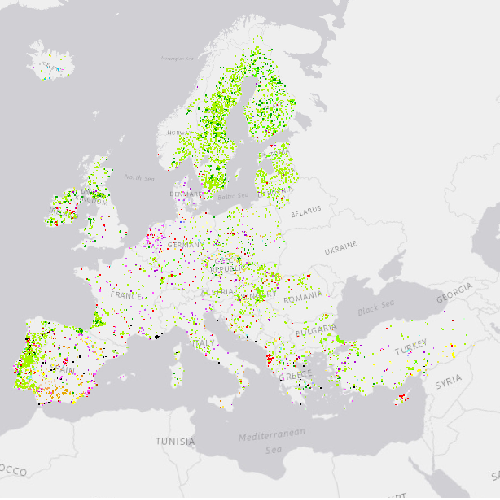
CORINE Land Cover (CLC) was specified to standardize data collection on land in Europe to support environmental policy development. The reference year of first CLC inventory was 1990 (CLC1990), and the first update created in 2000. Later the update cycle has become 6 years. The number of participating countries has increased over time − currently includes 33 European Environment Agency (EEA) member countries and six cooperating countries (EEA39) with a total area of over 5.8 Mkm2. Ortho-corrected high spatial resolution satellite images provide the geometrical and thematic basis for mapping. In-situ data (topographic maps, ortho-photos and ground survey data) are essential ancillary information. The project is coordinated by the EEA in the frame of the EU Copernicus programme and implemented by national teams under the management and quality control (QC) of the EEA. The basic technical parameters of CLC (i.e. 44 classes in nomenclature, 25 hectares minimum mapping unit (MMU) and 100 meters minimum mapping width) have not changed since the beginning, therefore the results of the different inventories are comparable. The layer of CORINE Land Cover Changes (CHA) is produced since the second CLC inventory (CLC2000). CHA is derived from satellite imagery by direct mapping of changes taken place between two consecutive inventories, based on image-to-image comparison. Change mapping applies a 5 ha MMU to pick up more details in CHA layer than in CLC status layer. Integration of national CLC and CHA data includes some harmonization along national borders. Two European validation studies have shown that the achieved thematic accuracy is above the specified minimum (85 %). Primary CLC and CHA data are in vector format with polygon topology. Derived products in raster format are also available. The seamless European CLC and CHA time series data (CLC1990, CLC2000, CLC2006, CLC2012, CLC2018 and related CHA data) are distributed in the standard European Coordinate Reference System defined by the European Terrestrial Reference System 1989 (ETRS89) datum and Lambert Azimuthal Equal Area (LAEA) projection (EPSG: 3035). Results of the CLC inventories can be downloaded from Copernicus Land site free of charge for all users. CLC data can contribute to a wide range of studies with European coverage, e.g.: ecosystem mapping, modelling the impacts of climate change, landscape fragmentation by roads, abandonment of farm land and major structural changes in agriculture, urban sprawl, water management.
-
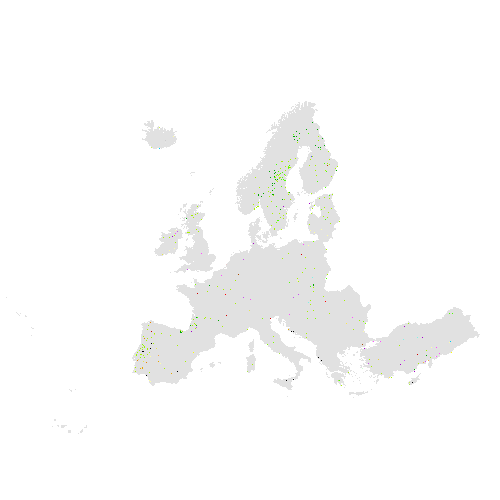
CORINE Land Cover (CLC) was specified to standardize data collection on land in Europe to support environmental policy development. The reference year of first CLC inventory was 1990 (CLC1990), and the first update created in 2000. Later the update cycle has become 6 years. The number of participating countries has increased over time − currently includes 33 European Environment Agency (EEA) member countries and six cooperating countries (EEA39) with a total area of over 5.8 Mkm2. Ortho-corrected high spatial resolution satellite images provide the geometrical and thematic basis for mapping. In-situ data (topographic maps, ortho-photos and ground survey data) are essential ancillary information. The project is coordinated by the EEA in the frame of the EU Copernicus programme and implemented by national teams under the management and quality control (QC) of the EEA. The basic technical parameters of CLC (i.e. 44 classes in nomenclature, 25 hectares minimum mapping unit (MMU) and 100 meters minimum mapping width) have not changed since the beginning, therefore the results of the different inventories are comparable. The layer of CORINE Land Cover Changes (CHA) is produced since the second CLC inventory (CLC2000). CHA is derived from satellite imagery by direct mapping of changes taken place between two consecutive inventories, based on image-to-image comparison. Change mapping applies a 5 ha MMU to pick up more details in CHA layer than in CLC status layer. Integration of national CLC and CHA data includes some harmonization along national borders. Two European validation studies have shown that the achieved thematic accuracy is above the specified minimum (85 %). Primary CLC and CHA data are in vector format with polygon topology. Derived products in raster format are also available. The seamless European CLC and CHA time series data (CLC1990, CLC2000, CLC2006, CLC2012, CLC2018 and related CHA data) are distributed in the standard European Coordinate Reference System defined by the European Terrestrial Reference System 1989 (ETRS89) datum and Lambert Azimuthal Equal Area (LAEA) projection (EPSG: 3035). Results of the CLC inventories can be downloaded from Copernicus Land site free of charge for all users. CLC data can contribute to a wide range of studies with European coverage, e.g.: ecosystem mapping, modelling the impacts of climate change, landscape fragmentation by roads, abandonment of farm land and major structural changes in agriculture, urban sprawl, water management.
-
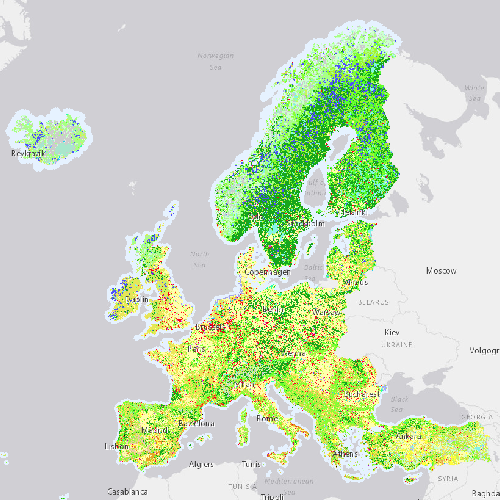
Corine Land Cover 2000 (CLC2000) is one of the datasets produced within the frame the Corine Land Cover programme referring to land cover / land use status of year 2000. The Corine Land Cover (CLC) is a European programme, coordinated by the European Environment Agency (EEA), providing consistent and thematically detailed information on land cover and land cover changes across Europe. CLC products are based on the classification of satellite images by the national teams of the participating countries - the EEA member and cooperating countries (EEA39). National CLC inventories are further integrated into a seamless land cover map of Europe. The resulting European database relies on standard methodology and nomenclature with following base parameters: 44 classes in the hierarchical 3-level CLC nomenclature; minimum mapping unit (MMU) for status layers is 25 hectares; minimum width of linear elements is 100 metres. Change layers have higher resolution, i.e. minimum mapping unit (MMU) is 5 hectares for Land Cover Changes (LCC), and the minimum width of linear elements is 100 metres. The CLC programme provides important data sets supporting the implementation of key priority areas of the Environment Action Programmes of the European Community as e.g. protecting ecosystems, halting the loss of biological diversity, tracking the impacts of climate change, monitoring urban land take, assessing developments in agriculture and implementing the EU Water Framework Directive. The CLC programme is a part of the Copernicus Land Monitoring Service (https://land.copernicus.eu/) run by the European Commission and the European Environment Agency, which provides environmental information from a combination of air- and space-based observation systems and in-situ monitoring. Additional information about CLC (product description, mapping guides and class descriptions) can be found here: https://land.copernicus.eu/user-corner/technical-library/.
-

Corine Land Cover Change 2012-2018 (CHA1218) is one of the Corine Land Cover (CLC) datasets produced within the frame the Copernicus Land Monitoring Service referring to changes in land cover / land use status between the years 2012 and 2018. CLC service has a long-time heritage (formerly known as "CORINE Land Cover Programme"), coordinated by the European Environment Agency (EEA). It provides consistent and thematically detailed information on land cover and land cover changes across Europe. CLC datasets are based on the classification of satellite images produced by the national teams of the participating countries - the EEA members and cooperating countries (EEA39). National CLC inventories are then further integrated into a seamless land cover map of Europe. The resulting European database relies on standard methodology and nomenclature with following base parameters: 44 classes in the hierarchical 3-level CLC nomenclature; minimum mapping unit (MMU) for status layers is 25 hectares; minimum width of linear elements is 100 metres. Change layers have higher resolution, i.e. minimum mapping unit (MMU) is 5 hectares for Land Cover Changes (CHA), and the minimum width of linear elements is 100 metres. The CLC service delivers important data sets supporting the implementation of key priority areas of the Environment Action Programmes of the European Union as e.g. protecting ecosystems, halting the loss of biological diversity, tracking the impacts of climate change, monitoring urban land take, assessing developments in agriculture or dealing with water resources directives. CLC belongs to the Pan-European component of the Copernicus Land Monitoring Service (https://land.copernicus.eu/), part of the European Copernicus Programme coordinated by the European Environment Agency, providing environmental information from a combination of air- and space-based observation systems and in-situ monitoring. Additional information about CLC product description including mapping guides can be found at https://land.copernicus.eu/user-corner/technical-library/. CLC class descriptions can be found at https://land.copernicus.eu/user-corner/technical-library/corine-land-cover-nomenclature-guidelines/html/.
-
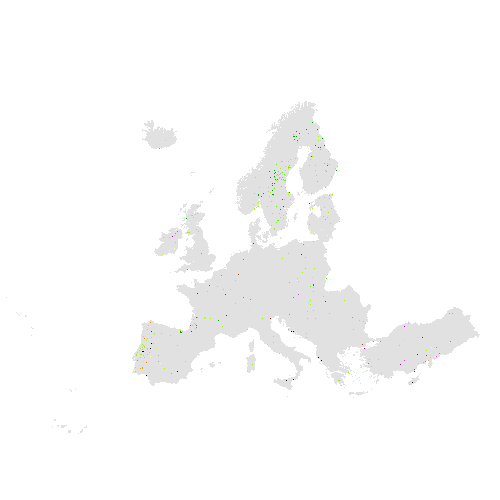
Corine Land Cover Change 2012-2018 (CHA1218) is one of the Corine Land Cover (CLC) datasets produced within the frame the Copernicus Land Monitoring Service referring to changes in land cover / land use status between the years 2012 and 2018. CLC service has a long-time heritage (formerly known as "CORINE Land Cover Programme"), coordinated by the European Environment Agency (EEA). It provides consistent and thematically detailed information on land cover and land cover changes across Europe. CLC datasets are based on the classification of satellite images produced by the national teams of the participating countries - the EEA members and cooperating countries (EEA39). National CLC inventories are then further integrated into a seamless land cover map of Europe. The resulting European database relies on standard methodology and nomenclature with following base parameters: 44 classes in the hierarchical 3-level CLC nomenclature; minimum mapping unit (MMU) for status layers is 25 hectares; minimum width of linear elements is 100 metres. Change layers have higher resolution, i.e. minimum mapping unit (MMU) is 5 hectares for Land Cover Changes (CHA), and the minimum width of linear elements is 100 metres. The CLC service delivers important data sets supporting the implementation of key priority areas of the Environment Action Programmes of the European Union as e.g. protecting ecosystems, halting the loss of biological diversity, tracking the impacts of climate change, monitoring urban land take, assessing developments in agriculture or dealing with water resources directives. CLC belongs to the Pan-European component of the Copernicus Land Monitoring Service (https://land.copernicus.eu/), part of the European Copernicus Programme coordinated by the European Environment Agency, providing environmental information from a combination of air- and space-based observation systems and in-situ monitoring. Additional information about CLC product description including mapping guides can be found at https://land.copernicus.eu/user-corner/technical-library/. CLC class descriptions can be found at https://land.copernicus.eu/user-corner/technical-library/corine-land-cover-nomenclature-guidelines/html/.
-

This dataset is the new version of the Effective Mesh Density (seff) 2016 dataset with improved input data, for the year 2015. This new dataset uses the Copernicus Imperviousness and the TomTom TeleAtlas datasets as fragmenting geometries. The Effective Mesh Density (seff) is a measure of the degree to which movement between different parts of the landscape is interrupted by a Fragmentation Geometry (FG). FGs are defined as the presence of impervious surfaces and traffic infrastructure, including medium sized roads. The more FGs fragment the landscape, the higher the effective mesh density hence the higher the fragmentation. The geographic coverage of the dataset is EEA39. An important consequence of landscape fragmentation is the increased isolation of ecosystem patches that breaks the structural connections and decreases resilience and ability of habitats to provide various ecosystem services. Fragmentation also influences human communities, agriculture, recreation and overall quality of life. Monitoring how fragmentation decreases landscape quality and changes the visual perception of landscapes provides information for policy measures that aim at improving ecosystem condition and restoration as well as maintaining the attractiveness of landscapes for recreational activities.
-
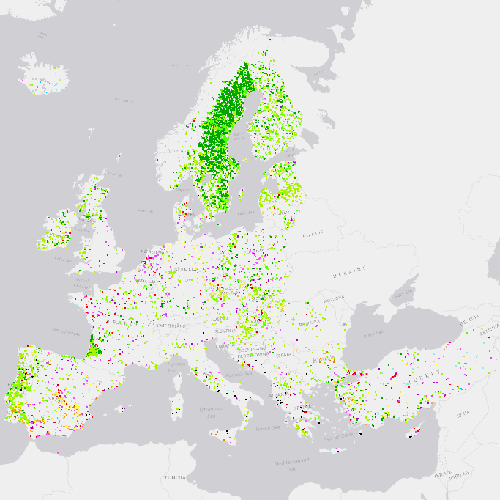
Corine Land Cover Change 2006-2012 (CHA0612) is one of the Corine Land Cover (CLC) datasets produced within the frame the Copernicus Land Monitoring Service referring to changes in land cover / land use status between the years 2006 and 2012. CHA is derived from satellite imagery by direct mapping of changes taken place between two consecutive inventories, based on image-to-image comparison. CLC service has a long-time heritage (formerly known as "CORINE Land Cover Programme"), coordinated by the European Environment Agency (EEA). It provides consistent and thematically detailed information on land cover and land cover changes across Europe. CLC datasets are based on the classification of satellite images produced by the national teams of the participating countries - the EEA members and cooperating countries (EEA39). National CLC inventories are then further integrated into a seamless land cover map of Europe. The resulting European database relies on standard methodology and nomenclature with following base parameters: 44 classes in the hierarchical 3-level CLC nomenclature; minimum mapping unit (MMU) for status layers is 25 hectares; minimum width of linear elements is 100 metres. Change layers have higher resolution, i.e. minimum mapping unit (MMU) is 5 hectares for Land Cover Changes (CHA), and the minimum width of linear elements is 100 metres. The CLC service delivers important data sets supporting the implementation of key priority areas of the Environment Action Programmes of the European Union as e.g. protecting ecosystems, halting the loss of biological diversity, tracking the impacts of climate change, monitoring urban land take, assessing developments in agriculture or dealing with water resources directives. CLC belongs to the Pan-European component of the Copernicus Land Monitoring Service (https://land.copernicus.eu/), part of the European Copernicus Programme coordinated by the European Environment Agency, providing environmental information from a combination of air- and space-based observation systems and in-situ monitoring. Additional information about CLC product description including mapping guides can be found at https://land.copernicus.eu/user-corner/technical-library/. CLC class descriptions can be found at https://land.copernicus.eu/user-corner/technical-library/corine-land-cover-nomenclature-guidelines/html/.
 RUC Geo-Data catalogue
RUC Geo-Data catalogue